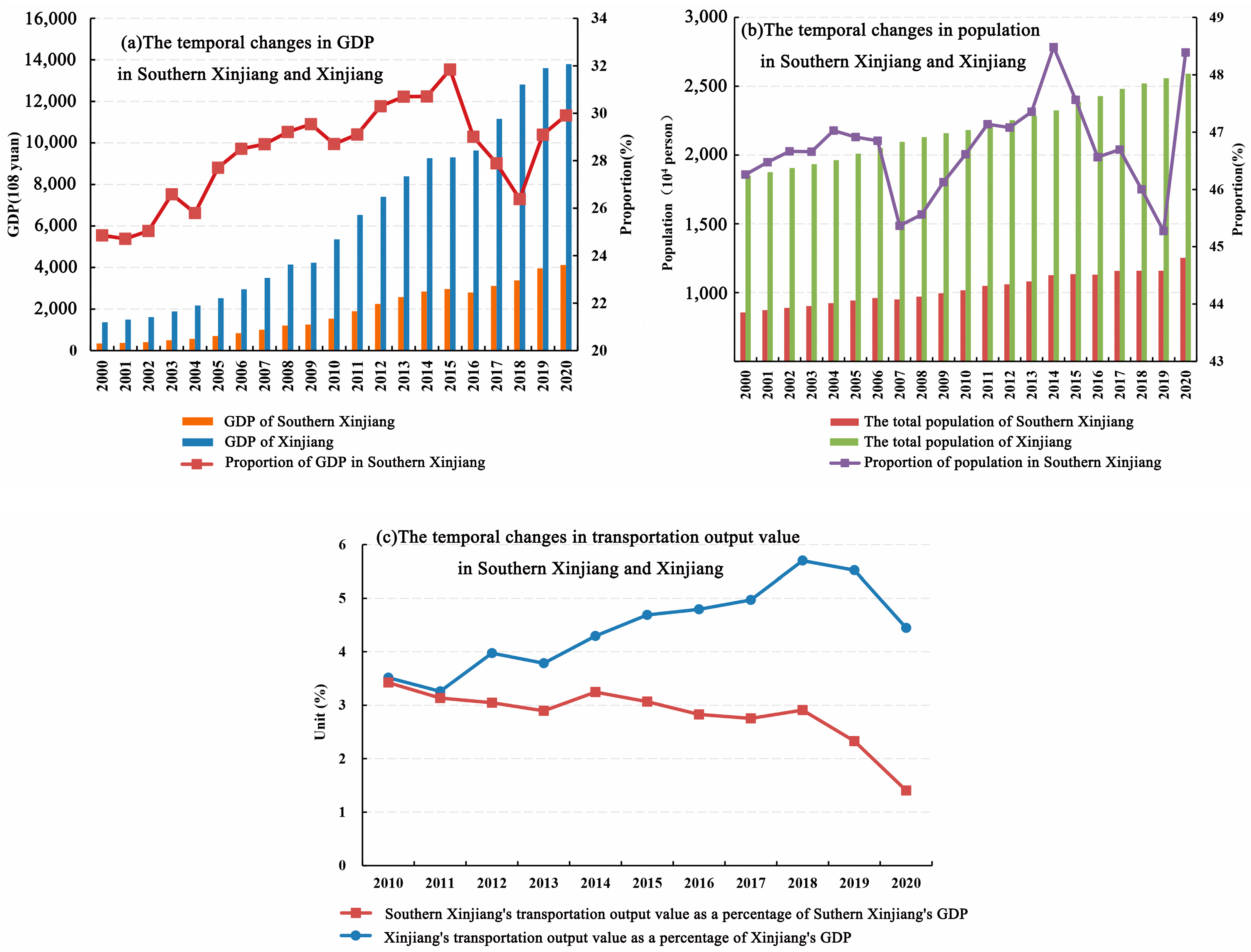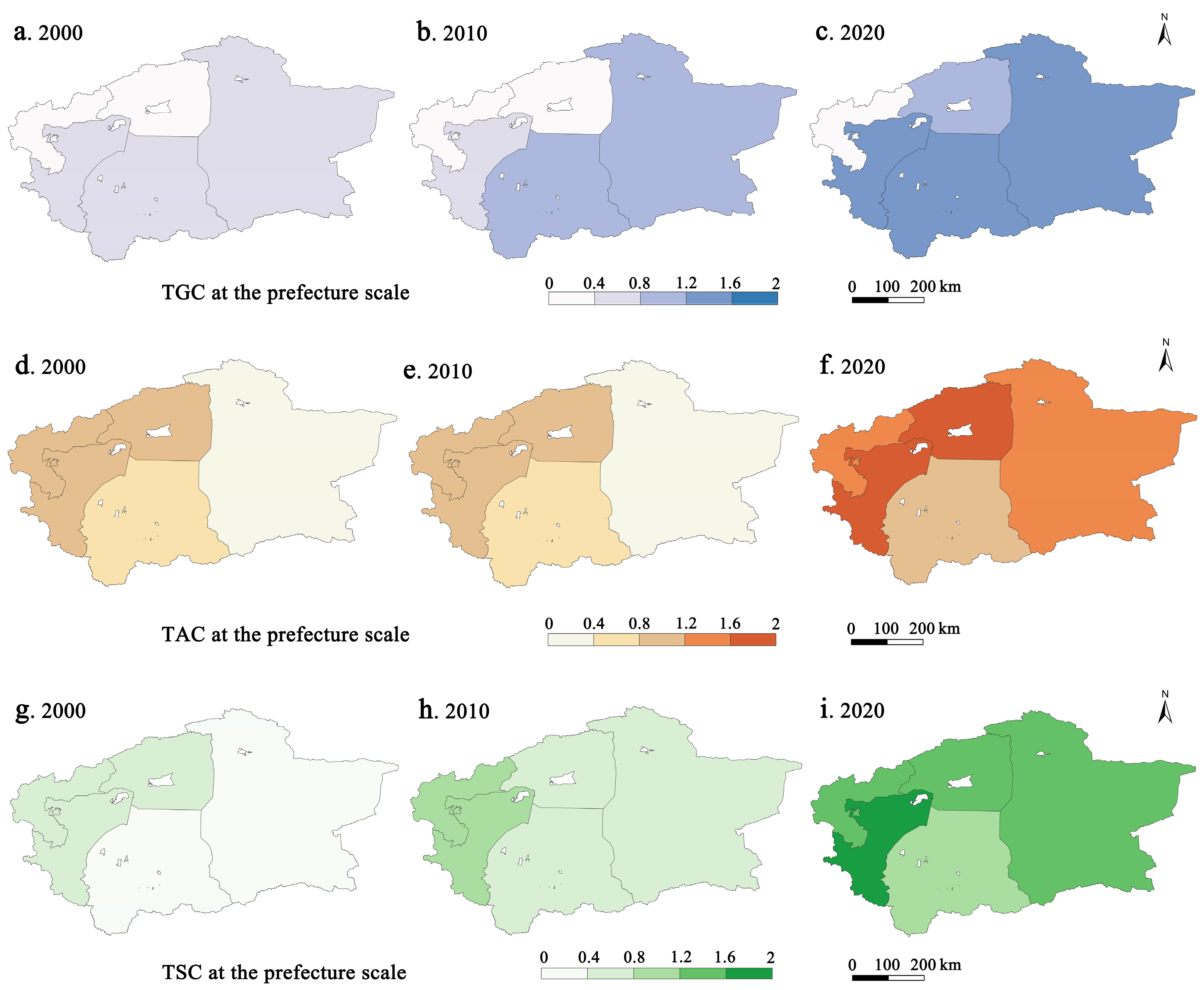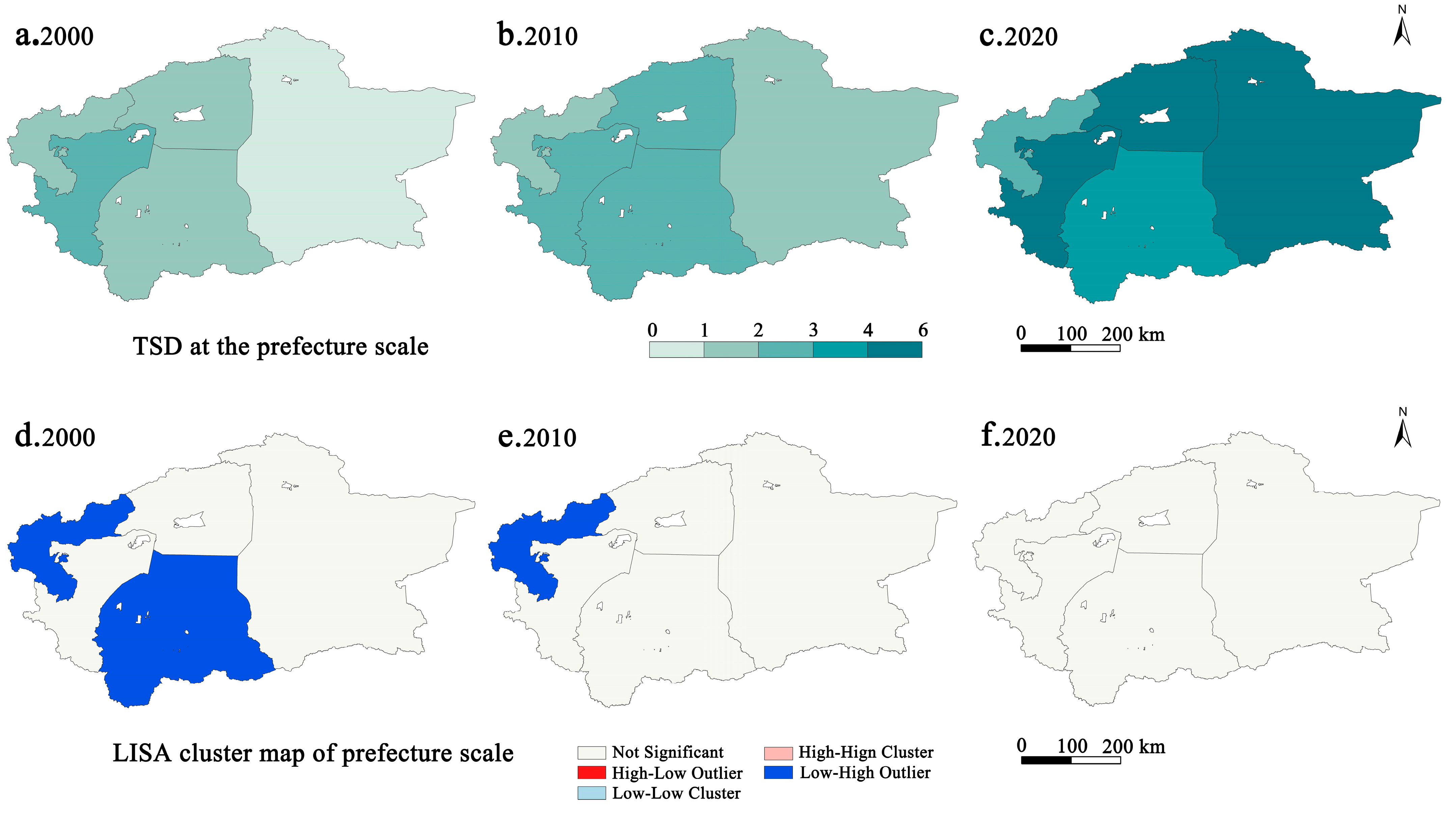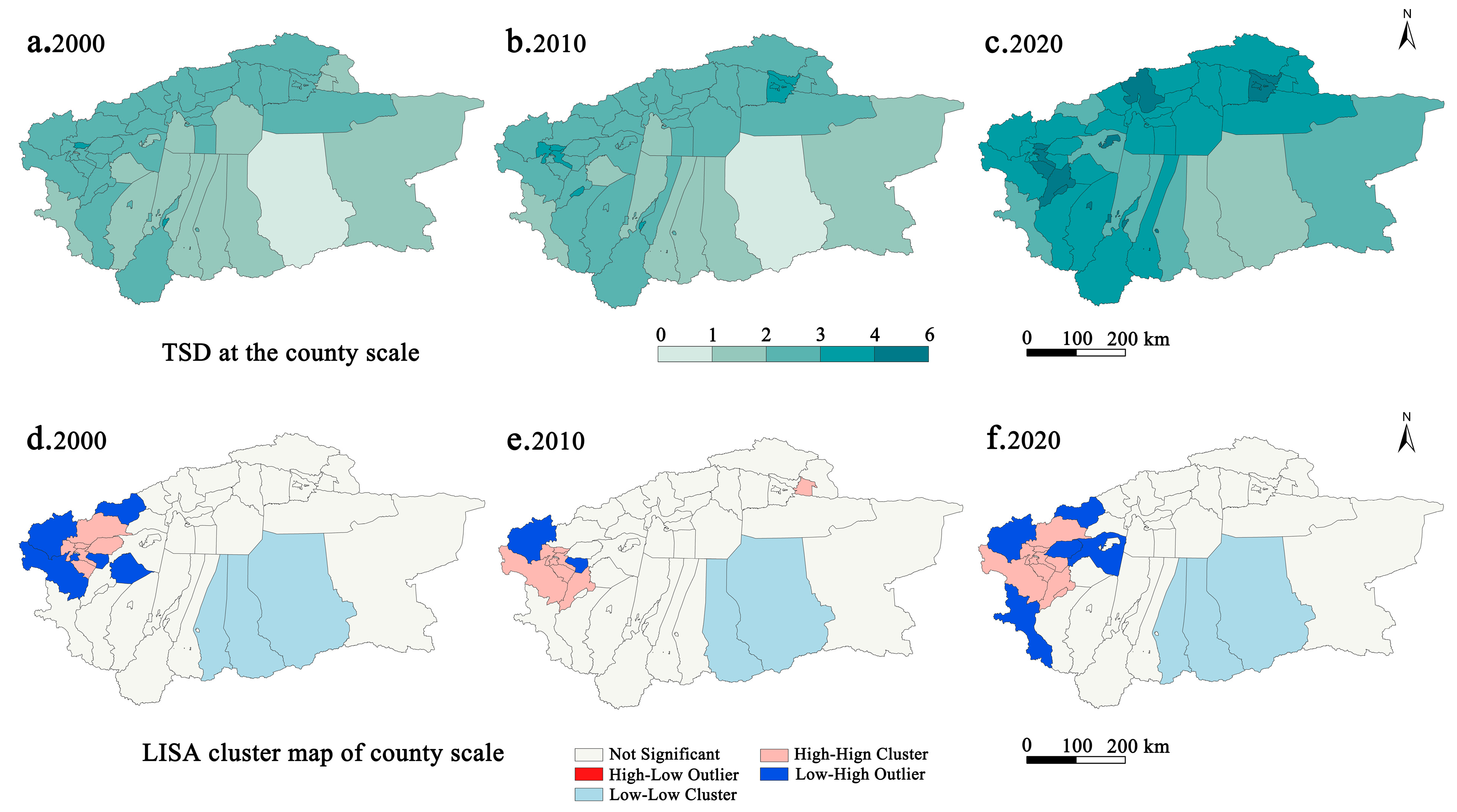The Evolution and Economic and Social Effects of the Spatial and Temporal Pattern of Transport Superiority Degree in Southern Xinjiang, China
Abstract
1. Introduction
2. Material and Methods
2.1. Study Area
2.2. Data Sources
2.3. Research Methods
2.3.1. Evaluation Method for TSD
Evaluate TSC
Evaluate TAC
Evaluate TGC
Evaluate TSD
2.3.2. Spatial Autocorrelation Analysis
2.3.3. Analysis of the Economic and Social Effects of TSD
2.3.4. The Coupled Coordination Model
3. Results
3.1. The Levels of TSD at Different Scales Gradually Increase, and the Spatiotemporal Patterns Show Significant Variation
3.2. County-Level TSD Has Significantly Impacted Economic and Social Development
3.3. The Coupling Coordination Levels between Different Scales of TSD and Economic and Social Development Have Gradually Improved
4. Discussion
4.1. Constructing Evaluation Indicators for TSD
4.2. Evolution of TSD Patterns at Different Scales and Their Economic and Social Effects
4.3. The Policy Implications for the Construction of Transportation Infrastructure in Southern Xinjiang
4.4. Limitations and Future Research Directions
5. Conclusions
Author Contributions
Funding
Institutional Review Board Statement
Informed Consent Statement
Data Availability Statement
Acknowledgments
Conflicts of Interest
References
- Vickerman, R.W. The Regional Impacts of Trans-European Networks. Ann. Reg. Sci. 1995, 29, 237–254. [Google Scholar] [CrossRef]
- Bowen, J. Airline Hubs in Southeast Asia: National Economic Development and Nodal Accessibility. J. Transp. Geogr. 2000, 8, 25–41. [Google Scholar] [CrossRef]
- Gutiérrez, J. Location, Economic Potential and Daily Accessibility: An Analysis of the Accessibility Impact of the High-Speed Line Madrid–Barcelona–French Border. J. Transp. Geogr. 2001, 9, 229–242. [Google Scholar] [CrossRef]
- Jin, F.J.; Wang, C.J.; Li, X.W. Discrimination Method and Its Application Analysis of Regional Transport Superiority. Acta Geogr. Sin. 2008, 63, 787–798. [Google Scholar]
- Du, Q.; Wang, X.; Li, Y.; Zou, P.X.W.; Han, X.; Meng, M. An Analysis of Coupling Coordination Relationship between Regional Economy and Transportation: Empirical Evidence from China. Environ. Sci. Pollut. Res. 2022, 29, 34360–34378. [Google Scholar] [CrossRef]
- Li, J.; Li, T.; Zhu, B.; Wang, Y.; Chen, X.; Liu, R. The Spatial Pattern and Influencing Factors of Traffic Dominance in Xi’an Metropolitan Area. Land 2023, 12, 1146. [Google Scholar] [CrossRef]
- Aderamo, A.J.; Magaji, S.A. Rural Transportation and the Distribution of Public Facilities in Nigeria: A Case of Edu Local Government Area of Kwara State. J. Hum. Ecol. 2010, 29, 171–179. [Google Scholar] [CrossRef]
- Huang, Y.; Zong, H. Spatiotemporal Evolution of Land Transportation Networks and Accessibility in Inland Mountainous Areas 1917–2017: A Case Study of Southwest China. J. Mt. Sci. 2020, 17, 2262–2279. [Google Scholar] [CrossRef]
- Wang, D.; Wang, K.; Wang, Z.; Fan, H.; Chai, H.; Wang, H.; Long, H.; Gao, J.; Xu, J. Spatial-Temporal Evolution and Influencing Mechanism of Traffic Dominance in Qinghai-Tibet Plateau. Sustainability 2022, 14, 11031. [Google Scholar] [CrossRef]
- Tian, T.; Ma, Y. Interactive Effect and Spatial Characteristics of Agricultural Development Level and Transport Superiority Degree in Main Grain-Producing Areas of the Central Jilin Province, China. Chin. Geogr. Sci. 2022, 32, 643–664. [Google Scholar] [CrossRef]
- Pulugurtha, S.S.; Mathew, S. Modeling AADT on Local Functionally Classified Roads Using Land Use, Road Density, and Nearest Nonlocal Road Data. J. Transp. Geogr. 2021, 93, 103071. [Google Scholar] [CrossRef]
- Aljoufie, M. The Impact Assessment of Increasing Population Density on Jeddah Road Transportation Using Spatial-Temporal Analysis. Sustainability 2021, 13, 1455. [Google Scholar] [CrossRef]
- Jiao, J.; Wang, J.; Zhang, F.; Jin, F.; Liu, W. Roles of Accessibility, Connectivity and Spatial Interdependence in Realizing the Economic Impact of High-Speed Rail: Evidence from China. Transp. Policy 2020, 91, 1–15. [Google Scholar] [CrossRef]
- Donert, K.; de Miguel Gonzalez, R. Innovative Learning Geography in Europe: New Challenges for the 21st Century; Cambridge Scholars Publishing: Cambridge, UK, 2014. [Google Scholar]
- Heppenstall, A.; Crooks, A.; Malleson, N.; Manley, E.; Ge, J.; Batty, M. Future Developments in Geographical Agent-Based Models: Challenges and Opportunities. Geogr. Anal. 2021, 53, 76–91. [Google Scholar] [CrossRef]
- Kasmalkar, I.G.; Serafin, K.A.; Miao, Y.; Bick, I.A.; Ortolano, L.; Ouyang, D.; Suckale, J. When Floods Hit the Road: Resilience to Flood-Related Traffic Disruption in the San Francisco Bay Area and Beyond. Sci. Adv. 2020, 6, eaba2423. [Google Scholar] [CrossRef] [PubMed]
- Nogal, M.; O’Connor, A.; Caulfield, B.; Martinez-Pastor, B. Resilience of Traffic Networks: From Perturbation to Recovery via a Dynamic Restricted Equilibrium Model. Reliab. Eng. Syst. Saf. 2016, 156, 84–96. [Google Scholar] [CrossRef]
- Banister, D.; Berechman, Y. Transport Investment and the Promotion of Economic Growth. J. Transp. Geogr. 2001, 9, 209–218. [Google Scholar] [CrossRef]
- Du, Y.; Wang, Y.; Li, W. Emergy Ecological Footprint Method Considering Uncertainty and Its Application in Evaluating Marine Ranching Resources and Environmental Carrying Capacity. J. Clean. Prod. 2022, 336, 130363. [Google Scholar] [CrossRef]
- Hu, Y.; Chen, Y. Coupling of Urban Economic Development and Transportation System: An Urban Agglomeration Case. Sustainability 2022, 14, 3808. [Google Scholar] [CrossRef]
- Wang, W.; Gong, J.; Yang, W.; Zeng, J. The Ecology-Economy-Transport Nexus: Evidence from Fujian Province, China. Agriculture 2022, 12, 135. [Google Scholar] [CrossRef]
- Cui, X.; Fang, C.; Wang, Z.; Bao, C. Spatial Relationship of High-Speed Transportation Construction and Land-Use Efficiency and Its Mechanism: Case Study of Shandong Peninsula Urban Agglomeration. J. Geogr. Sci. 2019, 29, 549–562. [Google Scholar] [CrossRef]
- Hong, J.; Chu, Z.; Wang, Q. Transport Infrastructure and Regional Economic Growth: Evidence from China. Transportation 2011, 38, 737–752. [Google Scholar] [CrossRef]
- Sun, J.; Li, Z.; Lei, J.; Teng, D.; Li, S. Study on the Relationship between Land Transport and Economic Growth in Xinjiang. Sustainability 2018, 10, 135. [Google Scholar] [CrossRef]
- Zhang, N.; Zhao, X.; Liu, T.; Lei, M.; Wang, C.; Wang, Y. Layout Planning of Highway Transportation Environment Monitoring Network: The Case of Xinjiang, China. Sustainability 2020, 12, 290. [Google Scholar] [CrossRef]
- Liu, T.; Wang, L.; Gao, H.; Xia, Y.; Guo, Z.; Li, W.; Liu, H. Research Progress on Train Operation Safety in Xinjiang Railway under Wind Environment. Transp. Saf. Environ. 2022, 4, tdac005. [Google Scholar] [CrossRef]
- Yu, N.; De Jong, M.; Storm, S.; Mi, J. The Growth Impact of Transport Infrastructure Investment: A Regional Analysis for China (1978–2008). Policy Soc. 2012, 31, 25–38. [Google Scholar] [CrossRef]
- Van Wee, B. Accessible Accessibility Research Challenges. J. Transp. Geogr. 2016, 51, 9–16. [Google Scholar] [CrossRef]
- Anselin, L. Local Indicators of Spatial Association-LISA. Geogr. Anal. 2010, 27, 93–115. [Google Scholar] [CrossRef]
- Wei, F.; Koc, E.; Li, N.; Soibelman, L.; Wei, D. A Data-Driven Framework to Evaluate the Indirect Economic Impacts of Transportation Infrastructure Disruptions. Int. J. Disaster Risk Reduct. 2022, 75, 102946. [Google Scholar] [CrossRef]
- Li, J.; Lei, J.; Li, S.; Yang, Z.; Tong, Y.; Zhang, S.; Duan, Z. Spatiotemporal Analysis of the Relationship between Urbanization and the Eco-Environment in the Kashgar Metropolitan Area, China. Ecol. Indic. 2022, 135, 108524. [Google Scholar] [CrossRef]
- Jiang, X.; He, X.; Zhang, L.; Qin, H.; Shao, F. Multimodal Transportation Infrastructure Investment and Regional Economic Development: A Structural Equation Modeling Empirical Analysis in China from 1986 to 2011. Transp. Policy 2017, 54, 43–52. [Google Scholar] [CrossRef]






| Data Types | Data Sources | Description |
|---|---|---|
| Transportation Data | Open Street Map (https://www.openstreetmap.org, accessed on 1 December 2022) | The data involve national highways, provincial highways, expressways, regular railways, county roads, airport and township roads |
| Socio-Economic Data | China County Statistical Yearbook (County and City Volume) (2001, 2011, and 2021); Xinjiang Statistical Yearbook (2001, 2011, and 2021); National Population Census Data (2001, 2011, and 2021); Xinjiang Prefecture Statistical Yearbook (2001, 2011, and 2021); Xinjiang 50-Year Statistical Yearbook (2001, 2011, and 2021); Government Economic and Social Development Statistical Bulletins of Various Prefectures, Counties, and Cities; | The data include indicators such as GDP, value-added of the primary sector, value-added of the secondary sector, value-added of the tertiary sector, urban population, local government general budget revenue, year-end savings deposits of urban and rural residents, and total retail sales of social consumer goods |
| Administrative Area Data | Chinese Academy of Sciences Resource and Environmental Science Data Center (http://www.resdc.cn, accessed on 1 December 2022) | The data are based on 2020 prefecture-level and county-level unit data |
| County Seat Data | / | |
| Land Use Data | Waterbody and desert land types in the Southern Xinjiang region were extracted from the land use data of the Xinjiang Uygur Autonomous Region and reclassified for regional statistics in various prefectures and county-level units | |
| Terrain Relief Data | Geographic Spatial Data Cloud (http://www.gscloud.cn, accessed on 1 December 2022) | The digital elevation model (DEM) data for the Southern Xinjiang region in Xinjiang were extracted based on GDEMDEM 30 m resolution elevation data, and after partitioned statistics of pixels, the average value was taken as the elevation for the region |
| Transport Type | Subtype of Transport | Score Requirements | Score [4] |
|---|---|---|---|
| Highway | Expressway | The expressway passes through urban areas | 2 |
| Within a range of 30 km | 1.5 | ||
| Within a range of 30–60 km | 1 | ||
| National highway | The national highway passes through built-up areas | 1.5 | |
| Within a range of 30 km | 1 | ||
| Provincial highway | The provincial highway passes through built-up areas | 1 | |
| County roads | The county road passes through built-up areas | 0.5 | |
| Township roads | The township road passes through | 0.2 | |
| Train | Conventional train | Having train stations | 1.5 |
| Within a range of 30 km | 1 | ||
| Airport | D/E-grade airport | Having D/E-grade airport | 2 |
| Within a range of 50 km | 1.5 | ||
| Within a range of 50–100 km | 1 | ||
| C-grade airport | Having C-grade airport | 1.5 | |
| Within a range of 50 km | 1 |
| Transport Type | Railway | Expressway | National Highway | Provincial Highway | County Road | Township Roads |
|---|---|---|---|---|---|---|
| Speed (km/h) | 120 | 100 | 80 | 60 | 40 | 30 |
| Time Cost (min) | 5 | 6 | 8 | 10 | 15 | 20 |
| Slope (°) | 0–5 | 5–15 | 15–25 | >25 |
| Time cost (min) | 120 | 180 | 300 | 500 |
| Dimension of Capability | Representation Connotation | Measurement Indicators | Attribute |
|---|---|---|---|
| TSC | The capacity to support and accommodate various types of transportation activities through transportation facilities | Road Density | + |
| Transport trunk line influence degree | + | ||
| TAC | The opportunities and potential brought to the region’s development by the transportation system | Internal Accessibility | + |
| Exterior Accessibility | + | ||
| TGC | The inherent level of network development within the transportation system and its ability to resist external influences | Connectivity of Transportation Routes | + |
| Desert Interference Index | - |
| Comprehensive Type | Coordination Index | Subtypes | Classification | Color |
|---|---|---|---|---|
| Coordination development | 0.9 < D ≤ 1 | Superiorly coordination | VIII | |
| 0.8 < D ≤ 0.9 | Good coordination | VII | ||
| 0.7 < D ≤ 0.8 | Intermediate coordination | VI | ||
| Transformation development | 0.6 < D ≤ 0.7 | Primary coordination | V | |
| 0.5 < D ≤ 0.6 | Barely coordination | IV | ||
| 0.4 < D ≤ 0.5 | Primary uncoordinated | III | ||
| Uncoordinated development | 0.2 < D ≤ 0.4 | Intermediate uncoordinated | II | |
| 0 < D ≤ 0.2 | Seriously uncoordinated | I |
| Variable | Economic Effects | Social Effects | ||||||
|---|---|---|---|---|---|---|---|---|
| LNGDP | LNPGDP | LNSGDP | LNTGDP | LNUP | LNBRLF | LNSAV | LNTSCG | |
| LNDEN | 0.683 * | −0.401 | 1.301 * | 0.202 * | 0.452 ** | 0.424 * | 0.333 * | 0.397 * |
| LNTID | 0.162 * | 0.384 ** | 0.058 * | 0.119 * | 0.043 * | 0.054 * | 0.368 * | 0.322 * |
| LNEA | −0.474 *** | −0.437 ** | −0.633 *** | −0.411 *** | −0.249 * | −0.046 * | −0.556 ** | −0.427 *** |
| LNIA | 0.038 * | 0.041 * | 0.083 * | 0.032 * | 0.024 * | 0.015 * | 0.021 ** | 0.051 * |
| LNRC | 0.112 * | 0.677 ** | 0.568 * | 0.213 ** | 0.085 * | 0.71 | 0.065 * | 0.109 * |
| LNDI | −0.141 * | −0.149 ** | −0.259 ** | −0.682 ** | −0.815 | −0.246 | −0.805 | −0.146 * |
| Direct Effects | LNGDP | LNPGDP | LNSGDP | LNTGDP | LNUP | LNBRLF | LNSAV | LNTSCG |
|---|---|---|---|---|---|---|---|---|
| LnTSC | 0.416 *** | 0.35 *** | 0.582 *** | 0.302 *** | 0.339 *** | 0.197 * | 0.34 ** | 0.422 *** |
| LnTAC | 0.254 *** | 0.155 * | 0.302 * | 0.275 *** | 0.181 ** | 0.373 * | 0.332 ** | 0.297 * |
| LnTGC | 0.116 *** | 0.15 *** | 0.123 *** | 0.813 *** | 0.108 ** | 0.744 | 0.103 | 0.533 * |
| LnTSD | 0.231 *** | 0.28 * | 0.931 * | 0.274 *** | 0.36 ** | 0.16 * | 0.26 * | 0.321 * |
| indirect effects | LNGDP | LNPGDP | LNSGDP | LNTGDP | LNUP | LNBRLF | LNSAV | LNTSCG |
| LnTSC | −0.714 * | 0.277 * | −0.145 ** | −0.579 * | −0.748 * | −0.14 * | −0.105 ** | −0.148 * |
| LnTAC | −0.194 ** | 0.711 * | −0.417 * | −0.559 * | −0.037 * | −0.174 * | −0.371 * | −0.105 * |
| LnTGC | −0.147 * | 0.218 * | −0.206 * | −0.476 * | −0.18 | −0.74 | −0.245 | −0.128 ** |
| LnTSD | −0.653 ** | 0.126 * | −0.373 * | −0.119 ** | −0.862 * | −0.158 * | −0.1 * | −0.189 * |
| The Coordinated Development Type | Economic and TSD | Social and TSD | ||||
|---|---|---|---|---|---|---|
| 2000 | 2010 | 2020 | 2000 | 2010 | 2020 | |
| Bayingolin Mongol Autonomous Prefecture | ||||||
| Aksu Prefecture | ||||||
| Kizilsu Kirghiz Autonomous Prefecture | ||||||
| Kashgar Prefecture | ||||||
| Hotan Prefecture | ||||||
| The Coordinated Development Type | Economic and TSD | Social and TSD | ||||
|---|---|---|---|---|---|---|
| 2000 | 2010 | 2020 | 2000 | 2010 | 2020 | |
| Korla City | ||||||
| Luntai County | ||||||
| Yuli County | ||||||
| Ruoqiang County | ||||||
| Qiemo County | ||||||
| Yanqi Hui Autonomous County | ||||||
| Hejing County | ||||||
| Hoxud County | ||||||
| Bohu County | ||||||
| Aksu City | ||||||
| Kuqa City | ||||||
| Wensu County | ||||||
| Xayar County | ||||||
| Xinhe County | ||||||
| Baicheng County | ||||||
| Wushi County | ||||||
| Awat County | ||||||
| Kalpin County | ||||||
| Artux City | ||||||
| Akto County | ||||||
| Akqi County | ||||||
| Wuqia County | ||||||
| Kashgar City | ||||||
| Shufu County | ||||||
| Shule County | ||||||
| Yengisar County | ||||||
| Zepu County | ||||||
| Shache County | ||||||
| Yecheng County | ||||||
| Makit County | ||||||
| Yopurga County | ||||||
| Jiashi County | ||||||
| Bachu County | ||||||
| Taxkorgan Tajik Autonomous County | ||||||
| Hotan City | ||||||
| Hotan County | ||||||
| Moyu County | ||||||
| Pishan County | ||||||
| Lop County | ||||||
| Qira County | ||||||
| Yutian County | ||||||
| Minfeng County | ||||||
| Aral City | ||||||
| Tumxuk City | ||||||
| Tiemenguan City | ||||||
| Kunyu City | ||||||
Disclaimer/Publisher’s Note: The statements, opinions and data contained in all publications are solely those of the individual author(s) and contributor(s) and not of MDPI and/or the editor(s). MDPI and/or the editor(s) disclaim responsibility for any injury to people or property resulting from any ideas, methods, instructions or products referred to in the content. |
© 2024 by the authors. Licensee MDPI, Basel, Switzerland. This article is an open access article distributed under the terms and conditions of the Creative Commons Attribution (CC BY) license (https://creativecommons.org/licenses/by/4.0/).
Share and Cite
Li, S.; Wang, H.; Liu, X.; Yang, Z. The Evolution and Economic and Social Effects of the Spatial and Temporal Pattern of Transport Superiority Degree in Southern Xinjiang, China. Land 2024, 13, 216. https://doi.org/10.3390/land13020216
Li S, Wang H, Liu X, Yang Z. The Evolution and Economic and Social Effects of the Spatial and Temporal Pattern of Transport Superiority Degree in Southern Xinjiang, China. Land. 2024; 13(2):216. https://doi.org/10.3390/land13020216
Chicago/Turabian StyleLi, Songhong, Hongwei Wang, Xiaoyang Liu, and Zhen Yang. 2024. "The Evolution and Economic and Social Effects of the Spatial and Temporal Pattern of Transport Superiority Degree in Southern Xinjiang, China" Land 13, no. 2: 216. https://doi.org/10.3390/land13020216
APA StyleLi, S., Wang, H., Liu, X., & Yang, Z. (2024). The Evolution and Economic and Social Effects of the Spatial and Temporal Pattern of Transport Superiority Degree in Southern Xinjiang, China. Land, 13(2), 216. https://doi.org/10.3390/land13020216






